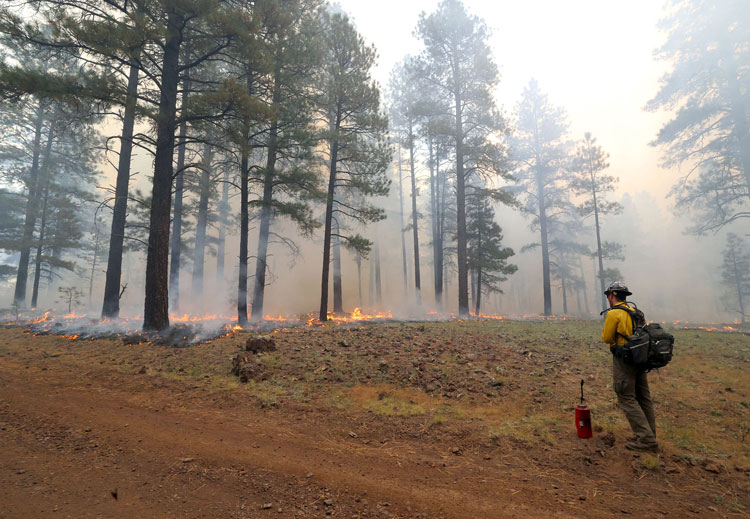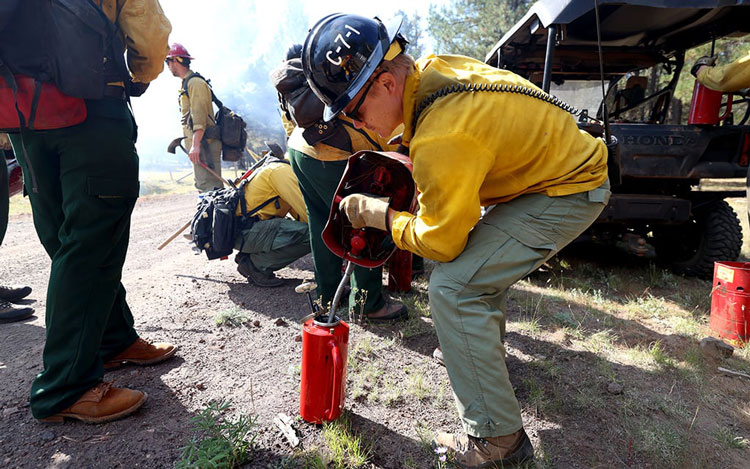Photo by Kevinjonah Paguio/Cronkite News: Ashton Johnson uses his drip torch during a prescribed burn operation in Kaibab National Forest on Oct. 5, 2023. Fire crews planned to burn around 2,300 acres of land that day.
By Kate Duffy/Cronkite News
WILLIAMS – It was just before 8 a.m. on a clear fall day when trucks carrying fire crews barreled down dirt roads into Kaibab National Forest.
Shortly after, the crews began to set over 2,300 acres of the ponderosa pine ecosystem ablaze.
The Kendrick Prescribed Fire Project was one of the first of many prescribed burns this fall and winter throughout Arizona to protect forest lands and surrounding communities from the threat of potentially catastrophic wildfires.
The prescribed burns in Kaibab National Forest are part of the U.S. Forest Service’s 10-year wildfire crisis strategy, which aims to combat wildfires in high-risk forest landscapes.
The strategy began in January 2022 as a response to the growing threat of wildfires in the West over the past 20 years due to climate change, accumulating fuels, and development. It emphasizes the restoration of fire-adapted ecosystems, which rely on regular fire exposure to stay healthy.
In other words, the Forest Service aims to fight fire with fire.
As part of the Inflation Reduction Act passed in 2022, the Forest Service will receive $5 billion over 10 years, including $1.8 billion that will be used to increase forest treatments in 11 new landscapes across Western states. Those treatments include prescribed burns.
Preventing catastrophic wildfires

Prescribed burns are a wildfire prevention method that involves burning an area of land in a controlled manner to minimize the risk of future catastrophic wildfires.
“The objective of many of these prescribed fires is to reduce forest fuels in the area,” said Zach Boness, burn boss for the prescribed burns in Kaibab National Forest. “We live in a fire-dependent ecosystem in northern Arizona, and so fire is part of how these trees remain healthy, how the forest remains healthy.”
“Forest fuels” refer to anything in the forest that can burn, including dead plants, dead trees, built-up leaves, and pine needles. If these materials aren’t burned away in a controlled manner they can build up and become fuel for dangerous wildfires, causing them to spread quickly and burn longer, making it difficult for fire crews to contain a wildfire once it starts.
In areas like the Kaibab forest, wildfires are often started by lightning strikes. When there is a lot of fuel on the forest floor, the fires can spread quickly.

Areas that have been pre-burned, though, don’t burn as intensely and often won’t burn at all since the forest fuels have already been burned off, according to Bob Blasi, a Kaibab National Forest fire information officer.
“A raging fire headed straight towards a pre-treated area will usually just go and drop,” Blasi said. “Wildfires can stop dead in their tracks when they hit a pre-treated piece of ground like this.”
According to Blasi, once a piece of land has burned, it likely won’t burn again for another 10 to 15 years.
“We do have empirical evidence that speaks to the effectiveness of these prescribed fires and other fuel treatments in slowing down and allowing us to be more successful when fire suppression is required,” Boness said.
Environmental benefits
The ponderosa pine forests in northern Arizona rely on regular fire exposure to encourage biodiversity.
“When you don’t have fires frequently, then the forests get very dense,” said Andrea Thode, a professor of fire ecology and fire science in the School of Forestry at Northern Arizona University. “The trees are very close together, they don’t grow in diameter and they don’t get a lot bigger.”
When there is an excess amount of trees, the amount of forest fuels on the ground increases, making it difficult for native plant species to flourish. Additionally, when the canopy of trees is thicker, less sunlight can reach the ground to encourage photosynthesis.
Where plants struggle to grow, wildlife struggles to live. Species such as elk rely on the forbs, grasses, and shrubs that grow in the ponderosa pine forests, but when forests are dense, they aren’t able to access their food supply.
Prescribed burns help manage forest density and burn off the build-up of fuels on the ground, allowing for more plants to grow. Additionally, when a prescribed fire burns through an area and blackens the trunks of trees, it leaves behind ash rich in minerals like phosphorus and nitrogen, Thode said. These minerals then soak into the soil on the ground and boost the plant growth.
Prescribed burns help ensure that these minerals can soak into the ground.

“At certain temperatures, nitrogen will volatilize, so it goes from that solid state to a gaseous state and is lost to the system,” Thode said, “but with low-severity fires, it’s released and so you do get an ash that has a lot of nitrogen and phosphorus in it.”
Thode said that even species that tend to prefer living in denser forest ecosystems benefit from prescribed burns. Mexican spotted owls, a threatened species that resides in northern Arizona forests, roost in dense groups of trees but they require more open areas when hunting for food.
“Removing the more continuous fuels, making (forests) more heterogeneous landscapes, changes the way that fire can move through that landscape to protect those areas, even if they do need to be more dense where the owls are nesting,” Thode said.
Prescribed burns do produce smoke, which releases carbon into the atmosphere, but according to Thode, it’s much less intense and harmful than the smoke from a catastrophic wildfire.
“It’s not really if it’s going to burn,” Thode said. “It’s when it’s going to burn and how it’s going to burn.”
The process of prescribed burns

These burns are planned months ahead of time. Early aspects of planning include organizing crews, planning burn locations, developing prescriptions, organizing permits, and informing the public.
“There’s more to it than just a bunch of cavemen dragging drip torches around,” Blasi said. “It’s a very detailed organization, and it requires a lot of experience level from the top to the bottom.”
Specialists also develop a burn plan, or “prescription.” This prescription takes into account weather, environmental risks, and location to determine the best conditions for a burn.
Then, crews head to the location to begin preparing. They prepare bulldozer lines, which are clear areas that act as barriers for a particular burn, and they clear out some of the harder-to-remove excess fuels with saws so that the burns are easier to control.

While plans are determined ahead of time, they are often subject to change due to the unpredictability of factors like weather and humidity.
“We’re prepping right up until the day of, making sure we have the resources that are needed and getting folks in place for all that,” Boness said.
On the day of, crews begin by gathering at a morning briefing led by burn bosses. Boness was the burn boss in charge of the prescribed burns in the Kaibab National Forest, aided by burn boss trainee Ryan Allen.
“We’re ultimately the ones in charge of the operations out here on our prescribed fire,” Boness said. “We coordinate with both our firing group and our holding group as well as coordinating between the agency administrator and our other overhead personnel to make sure we’re answering questions and that all the permits are in place, that all of our bases are covered so that we’re following our policy.”

At the briefing on Oct. 5, Boness and Allen went over the plans for the day’s burn to make sure everyone from each crew was on the same page and knew where they were assigned.
After the briefing comes the test fire, where the burn bosses observe a small, controlled fire to ensure that the forest conditions will allow for it to burn the way they want it to.
“If that’s successful for us if we see that we’re meeting our conditions, meeting our prescribed fire window, then we’ll continue with our general ignitions,” Boness said.
Following a successful test fire, the fire crews get to work. Ground crews first “blackline” the area set to burn, using drip torches to ignite thin lines of fire on the outer edges to act as a barrier preventing fires from spreading outside the prescribed area.

Then a helicopter equipped with a plastic sphere dispenser (PSD) drops small fireballs, no larger than a ping pong ball, inside the perimeter to burn the area quickly and efficiently while putting fewer workers at risk.
As the PSD operator for the prescribed burns in the Kaibab forest, Christian Cortes was in charge of releasing four to five fireballs per acre. Inside the PSD machine, the balls are injected with ethylene glycol, which causes them to ignite once they hit the ground.
“It’s like an art; there’s a certain way to do it to avoid balls from flying all over the place or losing control of anything,” Cortes said.
Throughout the prescribed burn process, safety is a priority, Blasi said. As firing crews lay down blacklines and the helicopter drops fireballs, holding crews drive trucks around the edges of burn areas to make sure that fire isn’t jumping from already burned “black” areas into unburned “green” areas. If they see a spot where the fire has jumped across the line, they put it out. Fires are continuously monitored as they burn through the night.

Additionally, each burn is assigned an air resource adviser and meteorologist. The adviser from the Arizona Department of Environmental Quality monitors the smoke to determine health risks while the meteorologist helps ensure that the burns are safe to complete under current weather conditions.
Sometimes areas are completely blocked off during prescribed burns for the safety of the public. The prescribed burns in the Kaibab forest, though, were deemed safe enough to allow people to drive next to where the fires were burning.
“We use it mostly for an opportunity to educate people,” Blasi said. “We want them to come up close to see it, we want them to understand why it’s important.”
Lindsay Nava, a recent graduate from NAU, said that the Forest Service’s work with prescribed burns is part of what inspired her to get involved in fire control. She has worked as a crewmember on various prescribed burn projects for the past year.
“People don’t go out and do this because they don’t care, you know?” Nava said. “And that’s why I love this job is because there are so many passionate people who really care about our public lands and our natural resources and it’s really great to be surrounded by that.”










